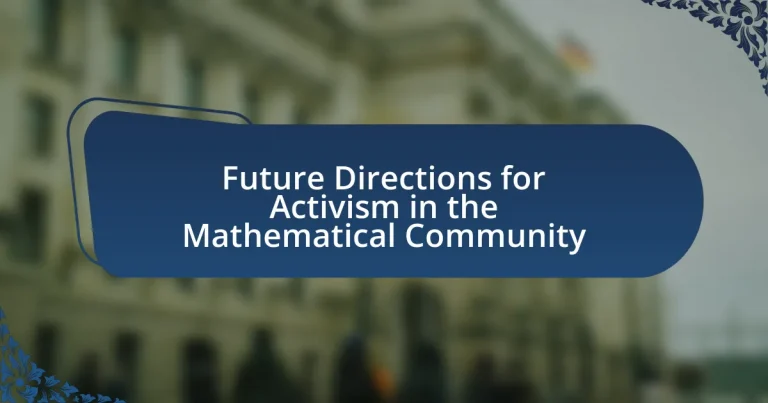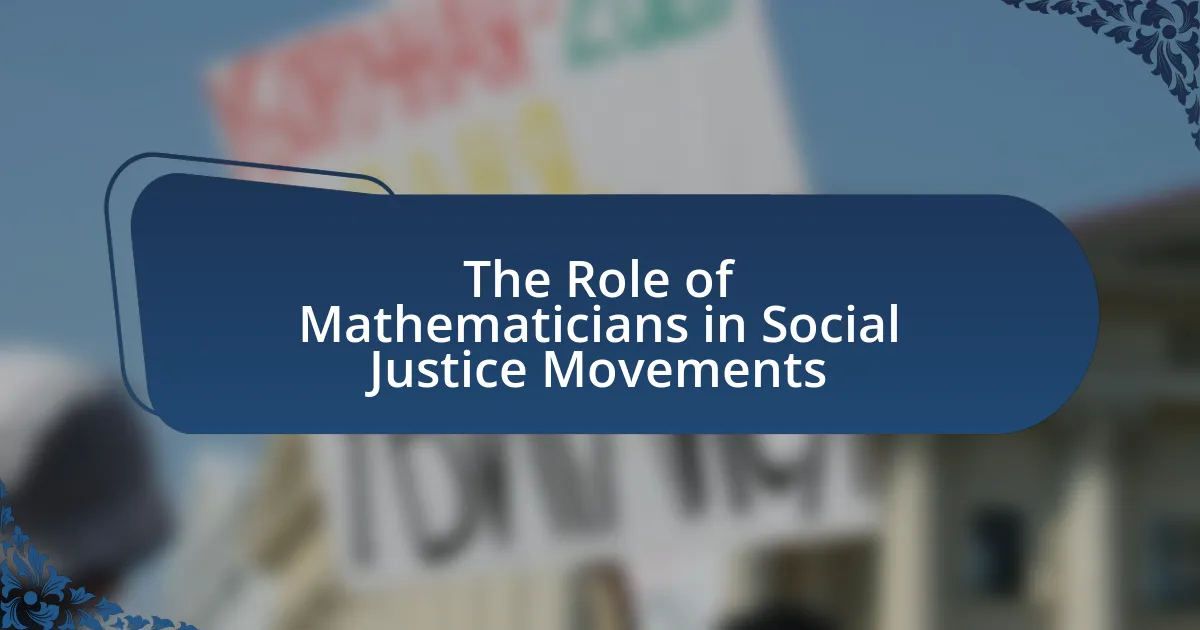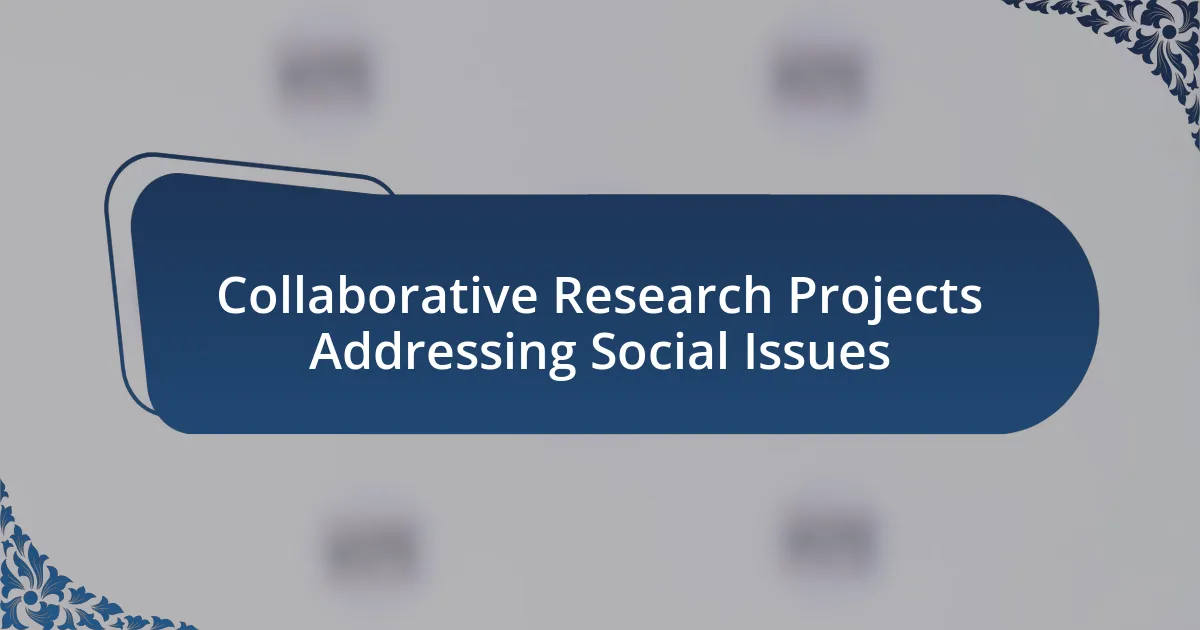The article focuses on the future directions for activism within the mathematical community, highlighting current trends such as diversity, equity, and inclusion, as well as advocacy for open access to research. It examines the evolution of activism in mathematics, shaped by historical events and contemporary social issues, and discusses the critical role mathematicians play in social justice movements. The article also addresses the challenges faced by the community in activism, including representation and institutional barriers, while proposing strategies for fostering a culture of activism and collaboration. Additionally, it emphasizes the importance of leveraging technology and data science to enhance activism efforts and outlines practical steps for mathematicians to engage in social issues effectively.
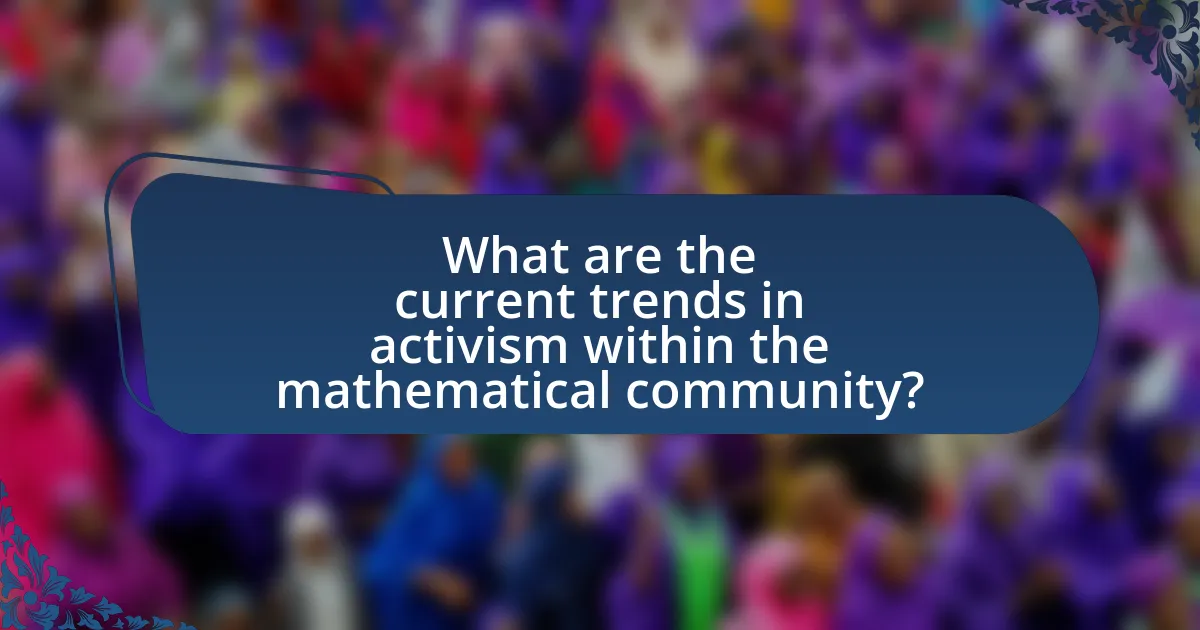
What are the current trends in activism within the mathematical community?
Current trends in activism within the mathematical community include a focus on diversity, equity, and inclusion, as well as advocacy for open access to research and educational resources. The mathematical community is increasingly addressing systemic inequalities by promoting initiatives that support underrepresented groups in mathematics, such as women and minorities. For instance, organizations like the American Mathematical Society have launched programs aimed at increasing participation from diverse populations. Additionally, there is a growing movement towards open access publishing, which seeks to make mathematical research freely available to the public, thereby enhancing accessibility and collaboration. This trend is supported by the rise of platforms that facilitate open sharing of research findings, such as arXiv.
How has activism evolved in the mathematical community over the years?
Activism in the mathematical community has evolved significantly from the early 20th century to the present day, transitioning from isolated efforts to organized movements addressing social justice, diversity, and equity. Initially, activism was primarily focused on issues like the promotion of mathematics education and the inclusion of underrepresented groups, exemplified by the establishment of organizations such as the National Association of Mathematicians in 1975. Over the years, the community has increasingly engaged in broader social issues, including advocating for policy changes in education and research funding, as seen in initiatives like the American Mathematical Society’s commitment to diversity and inclusion. This evolution reflects a growing recognition of the role that mathematics plays in societal issues, leading to collaborative efforts such as the Mathematics for Social Justice movement, which emphasizes the application of mathematical skills to address real-world problems.
What historical events have shaped mathematical activism?
Historical events that have shaped mathematical activism include the establishment of the Bourbaki group in the 1930s, which aimed to reformulate mathematics through a rigorous and systematic approach, influencing educational practices and mathematical discourse. Additionally, the civil rights movement in the 1960s prompted mathematicians to address social justice issues, leading to initiatives like the Mathematics Education Reform movement, which sought to make mathematics more accessible and relevant to diverse populations. The 2010s saw the emergence of movements such as “Mathematics for Social Justice,” which directly linked mathematical practices to activism, advocating for equity in education and the application of mathematics to societal issues. These events collectively illustrate the evolving relationship between mathematics and activism, highlighting the discipline’s role in addressing social challenges.
How do contemporary issues influence current activism efforts?
Contemporary issues significantly influence current activism efforts by shaping the priorities and strategies of activists. For instance, the rise of climate change awareness has led to increased mobilization around environmental justice, prompting organizations to focus on sustainable practices and policies. Additionally, social movements addressing racial inequality, such as Black Lives Matter, have galvanized activists to advocate for systemic reforms in policing and education. These contemporary issues not only dictate the themes of activism but also affect the methods employed, as seen in the use of social media platforms for organizing and raising awareness. The impact of these issues is evident in the growing intersectionality within movements, where activists increasingly address multiple social justice concerns simultaneously, reflecting the complexity of modern societal challenges.
What role do mathematicians play in social justice movements?
Mathematicians play a crucial role in social justice movements by applying quantitative analysis to identify and address systemic inequalities. They utilize statistical methods to analyze data related to social issues, such as income disparity, educational access, and healthcare inequities, providing evidence-based insights that inform policy decisions. For instance, mathematicians have contributed to the analysis of voting patterns and gerrymandering, demonstrating how mathematical modeling can reveal unfair electoral practices. Their expertise in data interpretation helps activists and organizations advocate for equitable policies and practices, thereby enhancing the effectiveness of social justice initiatives.
How can mathematicians leverage their skills for activism?
Mathematicians can leverage their skills for activism by applying quantitative analysis to social issues, thereby providing data-driven insights that inform policy decisions. For instance, mathematicians can utilize statistical modeling to analyze the impact of climate change, which can guide environmental policies. Additionally, they can engage in community outreach by teaching mathematical literacy, empowering individuals to understand and engage with data that affects their lives. Historical examples include mathematicians contributing to public health campaigns by modeling disease spread, as seen during the COVID-19 pandemic, where mathematical models were crucial in shaping public health responses.
What are some examples of successful activism by mathematicians?
Mathematicians have successfully engaged in activism through various initiatives, notably in advocating for social justice and educational reform. One prominent example is the “Mathematicians for Justice” movement, which emerged in response to systemic racism and inequality, where mathematicians organized to raise awareness and promote equitable practices in academia. Additionally, the “Mathematics and Social Justice” initiative has seen mathematicians collaborate with community organizations to apply mathematical modeling in addressing issues like food insecurity and public health. These efforts demonstrate the impactful role mathematicians can play in societal change, leveraging their expertise to influence policy and promote equity.
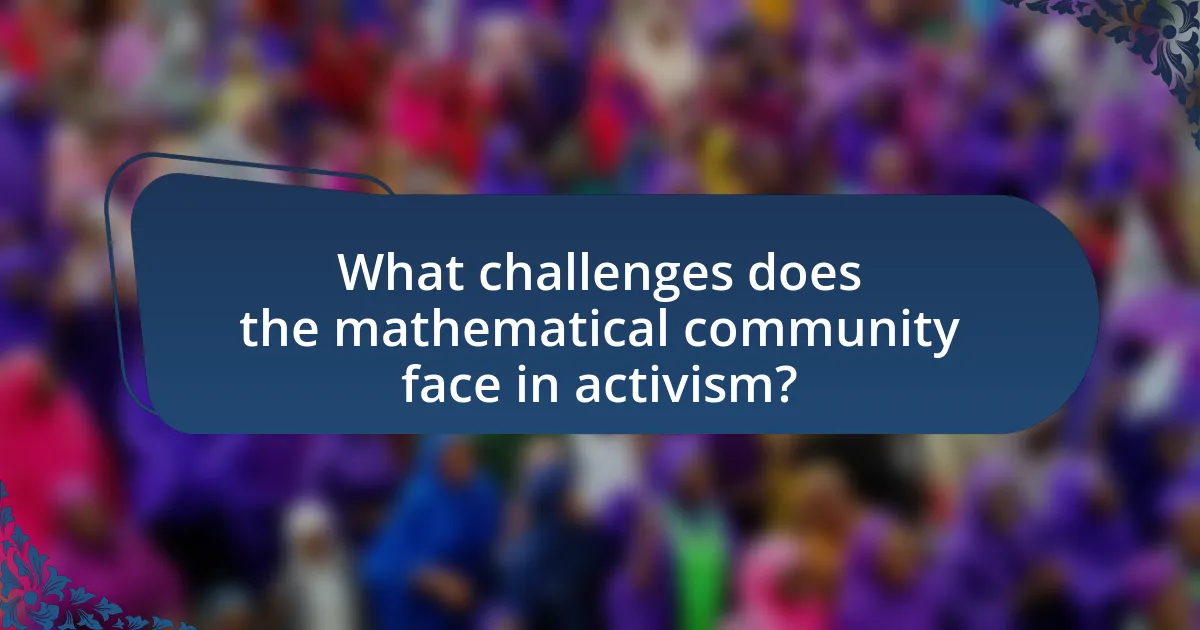
What challenges does the mathematical community face in activism?
The mathematical community faces several challenges in activism, including a lack of representation, limited resources, and resistance to change. The underrepresentation of diverse voices in mathematics hampers the community’s ability to address social issues effectively, as seen in the low participation rates of women and minorities in mathematical fields. Additionally, activists often struggle with insufficient funding and institutional support, which limits their capacity to implement initiatives. Resistance to change is prevalent within traditional academic structures, where established norms can hinder progressive movements. These challenges collectively impede the mathematical community’s efforts to engage in meaningful activism and advocate for social justice.
What barriers exist for mathematicians engaging in activism?
Mathematicians face several barriers when engaging in activism, including professional risks, lack of institutional support, and the perception of activism as outside their professional scope. Professional risks involve potential backlash from colleagues or institutions, which can affect career advancement and reputation. A lack of institutional support often means that mathematicians do not have access to resources or platforms to effectively engage in activism. Additionally, the perception that activism detracts from the rigor and objectivity expected in mathematical work can discourage mathematicians from participating in social issues. These barriers collectively hinder the involvement of mathematicians in activism, limiting their ability to influence societal change.
How do institutional policies impact activism in mathematics?
Institutional policies significantly shape activism in mathematics by establishing frameworks that either facilitate or hinder collective action. For instance, policies that promote diversity and inclusion can empower underrepresented groups within the mathematical community to advocate for equitable practices and representation. Conversely, restrictive policies, such as those limiting funding for outreach programs or imposing bureaucratic hurdles for organizing events, can stifle grassroots movements and reduce the effectiveness of activism. Evidence of this impact can be seen in initiatives like the American Mathematical Society’s commitment to diversity, which has led to increased participation from marginalized groups in mathematical conferences and organizations, thereby enhancing activism efforts.
What personal challenges do mathematicians encounter when advocating for change?
Mathematicians encounter several personal challenges when advocating for change, including fear of backlash, professional isolation, and emotional fatigue. Fear of backlash arises from potential negative reactions from peers or institutions, which can discourage mathematicians from voicing their opinions. Professional isolation occurs when mathematicians feel disconnected from colleagues who may not share their views on social issues, leading to a lack of support. Emotional fatigue can result from the ongoing struggle to effect change in a field that may resist it, causing burnout and diminishing motivation. These challenges can hinder effective advocacy and limit the impact of their efforts within the mathematical community.
How can the mathematical community overcome these challenges?
The mathematical community can overcome these challenges by fostering collaboration and inclusivity among its members. Initiatives such as interdisciplinary research projects and outreach programs can bridge gaps between diverse groups, enhancing participation and representation. For instance, organizations like the American Mathematical Society have implemented programs aimed at increasing diversity in mathematics, which has shown positive outcomes in engagement and retention rates. Additionally, creating platforms for dialogue and sharing resources can empower underrepresented voices, leading to a more equitable environment.
What strategies can be employed to foster a culture of activism?
To foster a culture of activism, organizations can implement strategies such as education, community engagement, and collaboration. Education initiatives can include workshops and seminars that inform members about social issues and the importance of activism, which can lead to increased awareness and participation. Community engagement through outreach programs can connect activists with local communities, allowing for a better understanding of their needs and fostering solidarity. Collaboration among different groups and disciplines can amplify voices and resources, creating a more unified front for activism. Research shows that organizations that prioritize these strategies see higher levels of member involvement and impact in their advocacy efforts.
How can collaboration enhance activism efforts in mathematics?
Collaboration can enhance activism efforts in mathematics by fostering diverse perspectives and pooling resources to address social issues effectively. When mathematicians work together, they can combine their expertise to develop innovative solutions to complex problems, such as educational inequities or access to mathematical resources. For instance, collaborative initiatives like the “Mathematics for Social Justice” movement demonstrate how collective efforts can lead to impactful educational reforms and community engagement. This approach not only amplifies the voices of underrepresented groups in mathematics but also creates a stronger, unified front that can advocate for systemic change.
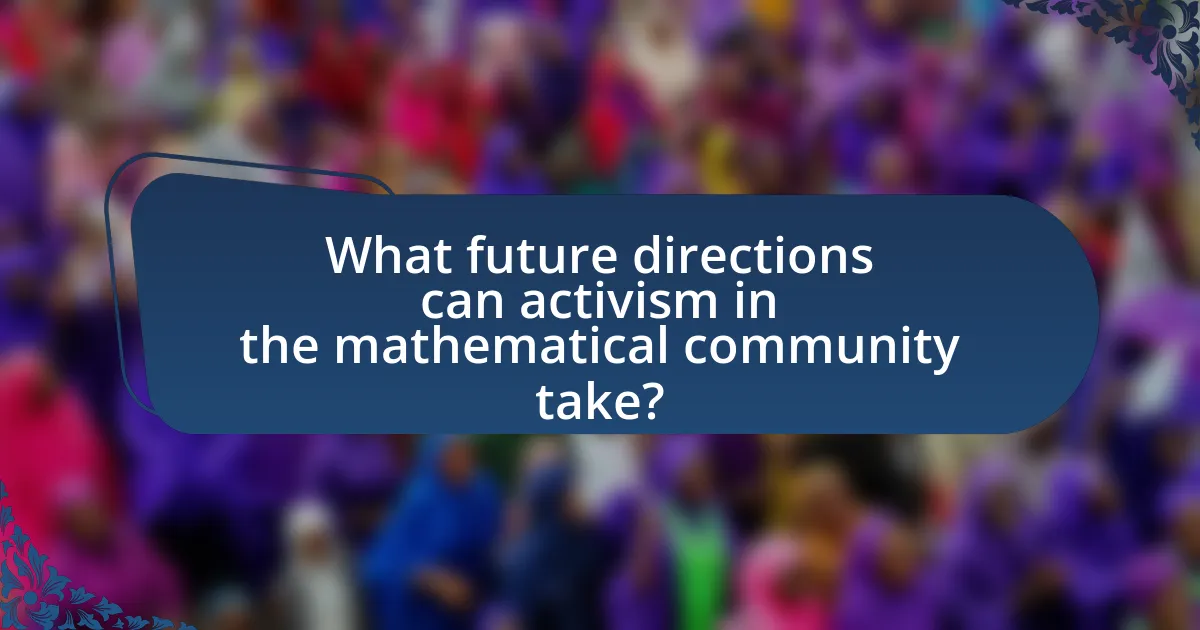
What future directions can activism in the mathematical community take?
Activism in the mathematical community can focus on promoting diversity, equity, and inclusion within the field. This direction is essential as studies have shown that diverse teams enhance creativity and problem-solving, leading to more innovative mathematical research. For instance, the National Science Foundation reports that diverse perspectives can significantly improve research outcomes and educational experiences. Additionally, activism can advocate for open access to mathematical resources, ensuring that knowledge is accessible to all, which aligns with the growing movement for transparency in academia. By addressing these issues, the mathematical community can foster a more inclusive environment that benefits both individuals and the discipline as a whole.
How can technology facilitate activism in mathematics?
Technology can facilitate activism in mathematics by providing platforms for collaboration, communication, and dissemination of information. Online tools such as social media, forums, and educational websites enable mathematicians and activists to share resources, organize events, and mobilize support for causes related to equity and access in mathematics education. For instance, initiatives like the “Mathematics for Social Justice” movement utilize digital platforms to connect educators and activists, promoting discussions on how mathematics can address social issues. Additionally, data visualization software allows activists to present mathematical data in compelling ways, making complex issues more accessible to the public and policymakers. This integration of technology not only enhances outreach but also fosters a community of engaged individuals advocating for change within the mathematical landscape.
What digital platforms are most effective for mathematical activism?
Social media platforms such as Twitter, Facebook, and Instagram are the most effective digital platforms for mathematical activism. These platforms facilitate the rapid dissemination of information, allowing activists to share mathematical insights, promote events, and engage with a broader audience. For instance, Twitter has been instrumental in organizing campaigns like #MathsForChange, which mobilizes mathematicians and enthusiasts to advocate for social issues through mathematical perspectives. Additionally, Facebook groups dedicated to mathematical activism provide a space for collaboration and discussion, enhancing community engagement. The visual nature of Instagram allows for creative representations of mathematical concepts, making activism more accessible and appealing to diverse audiences.
How can data science contribute to social justice initiatives?
Data science can significantly contribute to social justice initiatives by providing data-driven insights that identify and address systemic inequalities. For instance, data analysis can reveal disparities in access to education, healthcare, and employment opportunities among different demographic groups. A study by the Urban Institute found that data science techniques, such as predictive analytics, can help organizations allocate resources more effectively to underserved communities, thereby promoting equity. Additionally, data visualization tools can communicate complex social issues to a broader audience, fostering awareness and advocacy. By leveraging large datasets, data science empowers activists to make informed decisions and drive policy changes that support social justice goals.
What emerging issues should the mathematical community address through activism?
The mathematical community should address issues of diversity, equity, and inclusion through activism. These issues are critical as they impact representation and participation in mathematics, which has historically been dominated by certain demographics. For instance, studies show that underrepresented groups in STEM fields, including mathematics, face systemic barriers that hinder their advancement, such as bias in hiring and promotion practices. Addressing these barriers through targeted activism can lead to a more equitable environment, fostering innovation and collaboration. Additionally, the community should advocate for the integration of mathematics education in underserved areas, as access to quality education is essential for nurturing future mathematicians.
How can the community respond to climate change through mathematical advocacy?
The community can respond to climate change through mathematical advocacy by utilizing data analysis and modeling to inform policy decisions and public awareness. Mathematical models can predict climate trends, assess the impact of various interventions, and optimize resource allocation for sustainability efforts. For instance, the use of statistical methods to analyze climate data has shown that reducing carbon emissions can significantly mitigate global warming effects, as evidenced by research from the Intergovernmental Panel on Climate Change, which highlights the importance of quantitative analysis in understanding climate dynamics. By engaging in mathematical advocacy, the community can effectively communicate complex climate issues and advocate for evidence-based solutions.
What role does diversity and inclusion play in future activism efforts?
Diversity and inclusion are essential for future activism efforts as they enhance representation and broaden perspectives within movements. By incorporating diverse voices, activism can address a wider range of issues and foster innovative solutions that resonate with various communities. Research indicates that diverse teams are more effective in problem-solving and decision-making, as evidenced by a study published in the Harvard Business Review, which found that companies with higher diversity levels outperform their peers in profitability and value creation. This principle applies to activism, where inclusive practices can lead to more impactful and sustainable outcomes.
What practical steps can mathematicians take to engage in activism?
Mathematicians can engage in activism by applying their skills to social issues, advocating for equitable access to education, and participating in community outreach programs. They can use mathematical modeling to address problems such as climate change, public health, and social justice, thereby providing data-driven insights that inform policy decisions. Additionally, mathematicians can collaborate with organizations focused on advocacy, contribute to public discussions through writing and speaking engagements, and mentor underrepresented groups in mathematics to promote diversity in the field. These actions not only leverage their expertise but also amplify the impact of their work on societal challenges.
How can individuals start their own activism initiatives within the community?
Individuals can start their own activism initiatives within the community by identifying a specific issue they are passionate about and mobilizing resources to address it. This involves conducting research to understand the problem, engaging with community members to gather support, and forming a group or coalition to amplify their efforts. For instance, the National Council of Teachers of Mathematics emphasizes the importance of grassroots movements in education reform, highlighting that local initiatives can lead to significant changes in teaching practices and policies. By leveraging social media and local events, individuals can raise awareness and foster community involvement, ultimately driving their activism forward.
What resources are available for mathematicians interested in activism?
Mathematicians interested in activism can access various resources, including organizations, online platforms, and publications. Notable organizations such as the American Mathematical Society (AMS) and the Mathematical Association of America (MAA) provide support and networking opportunities for mathematicians engaged in social issues. Online platforms like Math for America and the Mathematicians for Social Justice initiative offer forums for collaboration and sharing of ideas. Additionally, publications such as “Mathematics and Social Justice” provide insights and case studies on the intersection of mathematics and activism, reinforcing the importance of mathematical contributions to societal issues.
